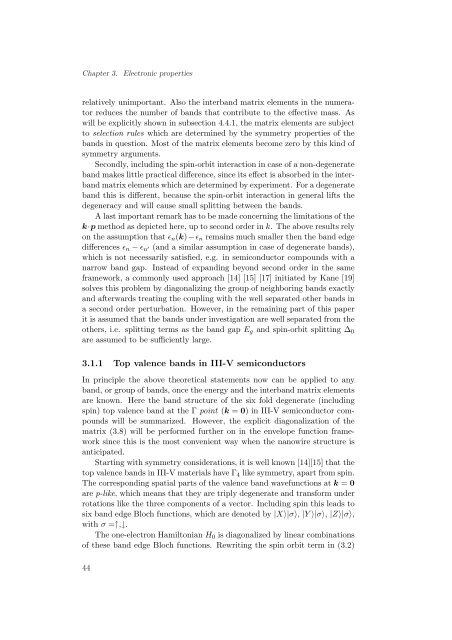Optical properties of cylindrical nanowires
Optical properties of cylindrical nanowires
Optical properties of cylindrical nanowires
Create successful ePaper yourself
Turn your PDF publications into a flip-book with our unique Google optimized e-Paper software.
Chapter 3.Electronic <strong>properties</strong>relatively unimportant. Also the interband matrix elements in the numeratorreduces the number <strong>of</strong> bands that contribute to the effective mass. Aswill be explicitly shown in subsection 4.4.1, the matrix elements are subjectto selection rules which are determined by the symmetry <strong>properties</strong> <strong>of</strong> thebands in question. Most <strong>of</strong> the matrix elements become zero by this kind <strong>of</strong>symmetry arguments.Secondly, including the spin-orbit interaction in case <strong>of</strong> a non-degenerateband makes little practical difference, since its effect is absorbed in the interbandmatrix elements which are determined by experiment. For a degenerateband this is different, because the spin-orbit interaction in general lifts thedegeneracy and will cause small splitting between the bands.A last important remark has to be made concerning the limitations <strong>of</strong> thek·p method as depicted here, up to second order in k. The above results relyon the assumption that ɛ n (k)−ɛ n remains much smaller then the band edgedifferences ɛ n − ɛ n ′ (and a similar assumption in case <strong>of</strong> degenerate bands),which is not necessarily satisfied, e.g. in semiconductor compounds with anarrow band gap. Instead <strong>of</strong> expanding beyond second order in the sameframework, a commonly used approach [14] [15] [17] initiated by Kane [19]solves this problem by diagonalizing the group <strong>of</strong> neighboring bands exactlyand afterwards treating the coupling with the well separated other bands ina second order perturbation. However, in the remaining part <strong>of</strong> this paperit is assumed that the bands under investigation are well separated from theothers, i.e. splitting terms as the band gap E g and spin-orbit splitting ∆ 0are assumed to be sufficiently large.3.1.1 Top valence bands in III-V semiconductorsIn principle the above theoretical statements now can be applied to anyband, or group <strong>of</strong> bands, once the energy and the interband matrix elementsare known. Here the band structure <strong>of</strong> the six fold degenerate (includingspin) top valence band at the Γ point (k = 0) in III-V semiconductor compoundswill be summarized. However, the explicit diagonalization <strong>of</strong> thematrix (3.8) will be performed further on in the envelope function frameworksince this is the most convenient way when the nanowire structure isanticipated.Starting with symmetry considerations, it is well known [14][15] that thetop valence bands in III-V materials have Γ 4 like symmetry, apart from spin.The corresponding spatial parts <strong>of</strong> the valence band wavefunctions at k = 0are p-like, which means that they are triply degenerate and transform underrotations like the three components <strong>of</strong> a vector. Including spin this leads tosix band edge Bloch functions, which are denoted by |X〉|σ〉, |Y 〉|σ〉, |Z〉|σ〉,with σ =↑,↓.The one-electron Hamiltonian H 0 is diagonalized by linear combinations<strong>of</strong> these band edge Bloch functions. Rewriting the spin orbit term in (3.2)44
















